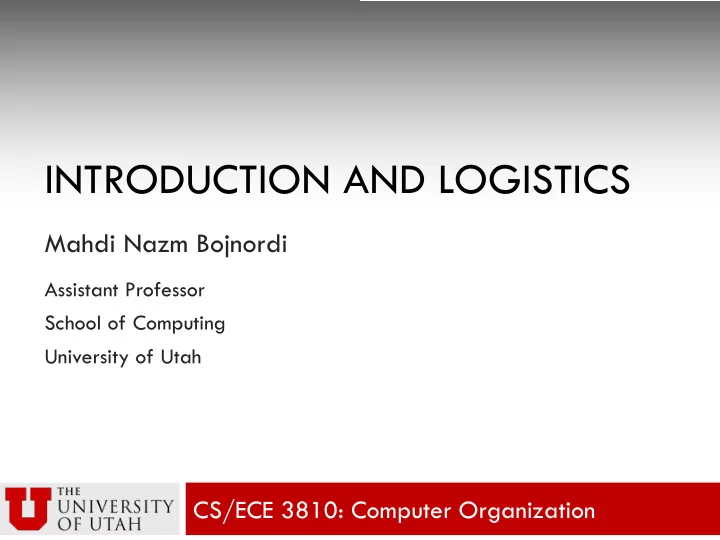

INTRODUCTION AND LOGISTICS Mahdi Nazm Bojnordi Assistant Professor School of Computing University of Utah CS/ECE 3810: Computer Organization
Overview ¨ This lecture ¤ Instructor ¤ Teaching assistants ¤ Course resources and requirements ¤ Academic integrity ¤ Computer organization ¤ Trends and challenges
Instructor ¨ Mahdi Nazm Bojnordi ¤ Assistant Professor of School of Computing ¤ PhD degree in Electrical Engineering ¤ Personal webpage: http://www.cs.utah.edu/~bojnordi/ ¨ Research in Computer Architecture ¤ Novel Memory Technologies ¤ Energy-Efficient Hardware Accelerators ¤ Research Lab. (MEB 3383) n Open positions for research are available! ¨ Office Hours (MEB 3418) ¤ Please email me for an appointment ¨ Class webpage: http://www.cs.utah.edu/~bojnordi/classes/3810/s19/
Webpage ¨ Please visit online
Teaching Assistants ¨ Sumanth Gudaparthi ¤ Email: sgudapar@cs.utah.edu ¨ Lin Jia ¤ Email: lin.jia@utah.edu ¨ Jac MacHardy ¤ Email: macharjk@gmail.com ¨ Taylor Smith ¤ Email: taysmith16@gmail.com
Resources and Requirements ¨ Textbook: Computer Organization and Design - The Hardware/Software Interface - 5th Edition, David Patterson and John Hennessy ¨ Pre-requisite: Knowledge of structured programming languages such as C/Java
Course Expectation ¨ We use Canvas for homework submissions, grades, and homework announcements. ¨ Grading Fraction Notes Assignments 30% homework assignments Midterm Exam 30% Thursday, February 21st Final Exam 40% Monday, April 29th Class Participation --% Questions and answers in class
Homework Assignments ¨ Homework assignments will be released on Canvas; all submissions must be made through Canvas. ¨ Only those submissions made before midnight will be accepted. ¨ Any late submission will be considered as no submission. ¨ You may skip 1 out of 10 (= we drop one HW with the least score).
Academic Integrity ¨ Do NOT cheat!! ¤ Please read the Policy Statement on Academic Misconduct, carefully. ¤ We have no tolerance for cheating ¨ Also, read to the College of Engineering Guidelines for disabilities, add, drop, appeals, etc. ¨ For more information, please refer to the important policies on the class webpage.
Academic Integrity ¨ Do NOT cheat!! ¤ Please read the Policy Statement on Academic Misconduct, carefully. ¤ We have no tolerance for cheating ¨ Also, read to the College of Engineering Guidelines for disabilities, add, drop, appeals, etc. ¨ For more information, please refer to the important policies on the class webpage.
Why CS/ECE 3810? ¨ Need another qualifier/graduation requirement?
Why CS/ECE 3810? ¨ Need another qualifier/graduation requirement? ¨ You plan to become a computer hardware engineer or computer architect?
Why CS/ECE 3810? ¨ Need another qualifier/graduation requirement? ¨ You plan to become a computer hardware engineer or computer architect? ¨ Understand what is inside a computer systems?
Why CS/ECE 3810? ¨ Need another qualifier/graduation requirement? ¨ You plan to become a computer hardware engineer or computer architect? ¨ Understand what is inside a computer systems? ¨ Want to use the knowledge from this course in your own field of study?
Why CS/ECE 3810? ¨ Need another qualifier/graduation requirement? ¨ You plan to become a computer hardware engineer or computer architect? ¨ Understand what is inside a computer systems? ¨ Want to use the knowledge from this course in your own field of study? ¨ Understand the technology trends and recent developments for future computing? ¨ …
Why study computer organization? ¨ Do the conventional computers last forever? ¤ New challenges ¤ New forms of computing
Why study hardware? ¨ Better understanding of today’s computing problems ¤ Security flaw: Spectre and Meltdown
Why study hardware? ¨ Better understanding of today’s computing problems ¤ Security flaw: Spectre and Meltdown ¤ How to fix?
Estimated Class Schedule ¨ Moore's Law, power wall, bandwidth wall ¨ Use of abstractions ¨ Assembly language ¨ Computer arithmetic ¨ Pipelining ¨ Using predictions ¨ Memory hierarchies ¨ Reliability and Security
Growth in Processor Performance
Growth in Processor Performance ¨ Main sources of the performance improvement ¤ Enhanced underlying technology (semiconductor) n Faster and smaller transistors (Moore’s Law) ¤ Improvements in computer organization/architecture n How to better utilize the additional resources to gain more power savings, functionalities, and processing speed.
Moore’s Law ¨ Moore’s Law (1965) ¤ Transistor count doubles every year ¨ Moore’s Law (1975) ¤ Transistor count doubles every two years Source: G.E. Moore, "Cramming more components onto integrated circuits," 1965
What are New Challenges? ¨ Resources (transistors) on a processor chip? ¨ Can we use all of the transistors? ¨ Who is affected? ¤ .
What are New Challenges? ¨ Resources (transistors) on a processor chip? ¤ Not really, billions of transistors on a single chip. ¨ Can we use all of the transistors? ¤ Due to energy-efficiency limitations, only a fraction of the transistor can be turned on at the same time! ¨ Who is affected? ¤ Server computers by the peak power ¤ Mobile and wearables due to energy-efficiency
Power Consumption Trends ¨ Power = P dynamic + P static ¨ P dynamic = axCxV 2 xf ¨ P static = VxI static Source: Hennesy & Patterson Textbook
What are New Challenges? ¨ Bandwidth optimization becomes a primary goal for memory design (Bandwidth Wall!)
What are New Challenges? ¨ Bandwidth optimization becomes a primary goal for memory design (Bandwidth Wall!)
What are New Challenges? ¨ Can in-package memory solve the problem? Off-chip Memory 3D Stacked Memory Lower Bandwidth Higher Bandwidth Lower Costs Higher Costs
What are New Challenges? ¨ Protecting data against side channel attacks is a serious need ¨ Performance in the past 40 years increased ¤ hardware speculation to exploit more instruction level parallelism ¤ shared memories to facilitate thread-level parallelism ¨ What about security? ¤ https://meltdownattack.com/
Unconventional Computing Systems ¨ How to program a Quantum computer? ¤ Qbit vs. bit
Emerging Non-volatile Memories ¨ Use resistive states to represent info. ¤ Can we build non-von Neumann machines? n In-Memory and In-situ computers
Next Class ¨ Lecture: Measuring Performance ¨ Todo: order the textbook
Recommend
More recommend